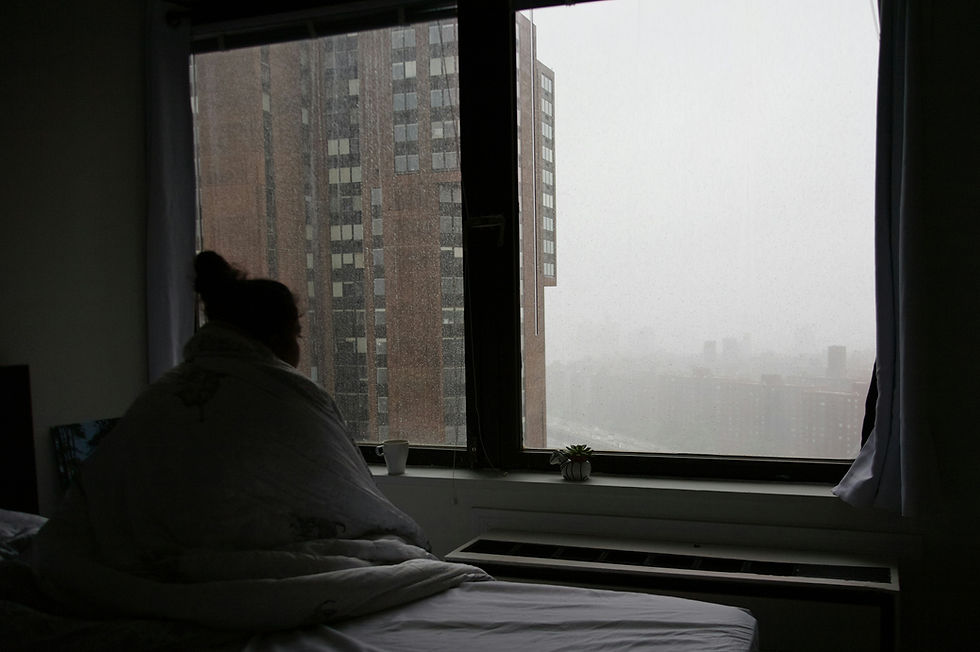Daily Tarot, Daily Tune-In: A Practice of Quiet Magic
- Suzanne Butler

- Jul 16
- 7 min read
Updated: Jul 17

There’s something exquisitely unremarkable about the moment it happens. A mug of coffee cooling on the windowsill. Sunlight not so much pouring in as reluctantly arriving. The shuffle, the cut, the stillness. And then: a card. A small rectangle of paperboard that somehow manages to capture the mood of the day, the vibe of your inner weather system, and the strange poetry of your half-formed questions—all at once.
Pulling a daily tarot card isn’t about fortune-telling. But you already knew that. It’s not about predicting whether that text will arrive, or if your boss will finally notice your subtle excellence, or whether Mercury will stop menacing your inbox. It’s about tuning in. Realigning. A quick recalibration between soul and self.
It’s the spiritual version of checking your teeth in the mirror before a Zoom call—not to change your fate, but to show up for it.
Let’s talk about why this humble ritual—this two-minute practice that fits between brushing your teeth and doomscrolling—can actually be the most radical kind of magic.
A Practice of Showing Up (To Yourself)
Here’s the thing about daily tarot pulls: they’re less about pulling the “right” card, and more about remembering that you’re allowed to pause. That you have an inner world worth checking in on, and a symbolic language with which to do it.
Let’s set the scene.
Imagine this: you wake up groggy. Your dog is giving you side-eye because walkies haven’t happened yet. You’ve already broken your “no phone before coffee” rule. There’s a low-level hum of anxiety about absolutely everything and nothing in particular.
And then—because you’re trying this “intuitive living” thing—you reach for your deck. No candles, no chanting (unless you count whisper-cursing at the cat who just knocked over your incense). Just you, the cards, and a kind of quiet hope.
You shuffle, pull, flip.
And suddenly—something clicks. You’re reminded that solitude isn’t failure. That your craving for quiet is not weird or indulgent. That maybe today is less about smashing goals and more about reclaiming stillness. You exhale.
That’s it. That’s the spell.
The Card as Mirror, Not Megaphone

One of the most liberating shifts in a tarot practice is moving away from the idea that the cards are telling you something. Instead, they’re reflecting something back. Tarot, especially in the context of a daily pull, isn’t about revelation—it’s about recognition.
The card doesn’t yell over your inner noise; it harmonises with it.
When you approach it like that, something shifts. You stop asking, “What’s going to happen to me today?” and start asking, “How can I meet today with more presence, more grace, more self-awareness?” That one-degree turn—from external prediction to internal permission—is what makes this a soul-tuning practice, not a performance. It stops being about “answers” and starts being about alignment.
The Jung of It All (and the Collective Coffee-Fueled Unconscious)
Let’s dip our toes into the deep end for a moment. Carl Jung (your fave Swiss dream daddy of analytical psychology) saw tarot as a system of archetypes—a symbolic language that maps directly onto the psyche.
In other words, tarot doesn’t just work because it’s mysterious. It works because it’s familiar at the deepest possible level. You’re not being given alien concepts—you’re being reminded of patterns already living in your subconscious.
So when you pull Strength, it’s not a moral instruction—it’s an invitation to connect with the archetype of inner fortitude. When you pull the Eight of Cups, you’re not being told to abandon ship—you’re being offered an image of emotional evolution. These aren’t rules. They’re reminders.
Your daily card becomes a kind of archetypal tuning fork. It reverberates through your day, amplifying the parts of you that most need expression, attention, or healing.
It’s a Little Bit Witchy, and a Little Bit Wired

Let’s be honest: the world doesn’t exactly reward daily stillness. We’re trained to measure our lives in productivity metrics and push notifications. We know how to check our steps, our stats, our screen time. But how often do we check our soul’s signal strength?
Pulling a daily card is your moment to say, “Hey, inner self—you good?”
It’s a soft refusal of a world that constantly demands output. It’s five minutes of input. Your input. It’s ritual as resistance.
And here’s the kicker: you don’t have to believe anything mystical to benefit from it. You can be a woo-woo witch in velvet or a therapist-in-training with a healthy dose of skepticism. The magic is in the attention, not the aesthetic.
The Stories We Tell (and the Ones We Rewrite)
Here’s a fictional (but very real) example.
Let’s call her Rae.
Rae is mid-thirties, newly self-employed, has a tendency to overcommit, and keeps a deck tucked into the side drawer of her desk under a sea of highlighters and half-burned Palo Santo. Her mornings are usually a rush—emails, meetings, the dog whining for his midday constitutional. But before she logs on, she pulls a card. No fanfare. No filters. Just a card.
One Tuesday, it’s the Five of Pentacles.
Her gut reaction: ugh. That card. The “lack” card. The “I’m broke, I’m tired, I’m abandoned” card. It doesn’t match her carefully crafted Instagram vibe.
But instead of brushing it off or swapping it for something prettier (don’t lie, we’ve all done it), Rae sits with it. She remembers the core image—two figures in the snow, hunched, moving forward, but right beside a glowing window. The light is there. But they don’t see it.
And she thinks: Where am I trudging forward without looking up?
She realises she hasn’t checked in with her support systems lately. She’s been doing the whole “I’m fine, I’m strong, I’ve got this” routine—but she’s also lonely. The card isn’t predicting doom. It’s pointing her toward a gap in her own awareness.
She texts a friend. They make plans. It’s small, but it shifts something.
That’s the kind of magic we’re talking about.
So What’s the “Right” Way to Do It?
You probably don’t need a how-to—but let’s be cheeky and throw one in anyway.
Pick your deck – use the one that feels alive in your hands. Not the one that looks best on your altar. (Unless that’s the same one. Bonus.)
Time it right – morning is classic, but lunch breaks and moonlit kitchen moments work just as well.
Ask less, receive more – no need for a grand question. A simple, “What energy am I working with today?” will do.
Pull with presence – shuffle, breathe, and let your hands decide.
Write it down (if you want) – not to track “accuracy” but to watch how your inner patterns unfold over time.
Live with it – let the card walk with you through your day. Not as an instruction manual, but as a soft-spoken companion.
There are no gold stars here. No tarot police. Just you, checking your soul mirror before heading out into the world.
When the Cards Feel Off (Or Worse, Scary)

Let’s address the occasional elephant in the room: what if you pull something… unpleasant?
First of all, congrats. You’ve been handed a masterclass in self-awareness.
Second, remember this: daily cards aren’t threats. They’re thresholds. If a card feels “bad,” it’s usually shining a spotlight on something already happening under the surface. It’s not summoning chaos. It’s giving you a name for the chaos already stirring.
It’s like a well-meaning friend who tells you your fly is down before you go on stage. Embarrassing? Maybe. Helpful? Absolutely.
Reframing “negative” cards is part of the deeper daily pull journey. They’re the ones that build nuance, depth, and emotional resilience into your practice. They give you symbolic language for discomfort—and that’s a gift.
Tarot as Tuning Fork, Not Megaphone
Let’s go back to the idea of tuning. When musicians tune their instruments, they’re not rewriting the music—they’re simply aligning the instrument with its ideal frequency. That’s what your daily card does for your psyche.
Some days, the card will feel bang-on, a mic-drop of uncanny relevance. Other days, it may feel obscure, abstract, or like it’s describing someone else entirely. That’s fine. Let it marinate. You’re not meant to solve the card. You’re meant to live with it.
Think of it like a scent that lingers all day. Not overpowering. Just enough to make you notice when the wind shifts.
The Subtle Alchemy of Repetition

There’s a quiet power in doing the same small thing every day.
Not because it gets more glamorous. But because it deepens.
You begin to notice patterns—not just in the cards, but in yourself. How often you pull the same suit. How certain cards track with certain moods. How your relationship to a particular archetype evolves over time.
You’re no longer just pulling cards. You’re in relationship with them.
And through that relationship, you start rewriting the story you tell about yourself. You see your own cycles, your own weather patterns. And in that self-seeing, something beautiful happens: compassion grows.
Final Thought: This is Your Ritual. Make It Yours.
There’s no right way to pull a daily card. Light a candle or don’t. Journal or don’t. Share it online or keep it a sacred secret. The practice isn’t sacred because of how it looks. It’s sacred because of how it feels.
What matters is that you come back. Not to be good at tarot. But to stay close to yourself.
So tomorrow morning, when the world starts whirring again and your coffee’s gone tepid and your to-do list is already muttering obscenities, pause.
Shuffle. Pull. Breathe.
And tune in.
Bonus Prompt (because you’re a curious human): Next time you pull your daily card, don’t ask what it means. Ask what it’s mirroring. See what shifts.
Liked this piece? Follow me for more soulful tarot reflections, healing frameworks, and tools for intuitive growth. Or visit www.the-healing-tarot.com to explore our courses and offerings.





I enjoyed this article, I work with Tarot but often for other people rather than myself and usually my daily card is about' what do I need to know today' energies so with healing in mind I drew the three of pentacles today - my interpretation was building solid foundations for the future through teamwork - mind, body and Spirit working in harmony and unity together. In other words take time to commune with my inner self :)